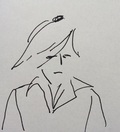What is your background?
I studied cognitive sciences in France. More precisely, I started with mathematics, and then I went on to experimental psychology. I did my PhD on signal processing, in Grenoble. Then I did a few post docs in computer sciences, neurosciences and psychology, all around the world (UK, Japan, France and USA).
What brought you to neuroesthetics?
I don’t consider myself a neuroestheticist! I am interested in understanding how people see and memorize. Besides that, what links me to neuroesthetics, indirectly, may be my PhD work on optical illusion, where I produced hybrid images of Marilyn Monroe and Albert Einstein that are now displayed in art museums.
What led you to the idea of studying memorability?
Memory is the soul. I believe there is a universal and common memory, shared by, let’s say, 50% of the people around the world. Memory is obviously related to culture, but I am interested in the memory that is the least dependent on culture.
How do you relate your work to subliminal images?
The first impression is what matters to me. This is not necessarily dependent on beauty and that is what fascinates me.
Are you an artist?
I appreciate art but I don’t consider myself an artist. However I am proud to have my hybrid optical images displayed in a museum, even though they are not pieces of art in the traditional sense.
Who are your favorite artists?
I like paintings the most. Especially those by Kandinsky or Picasso (cubists). I just love Vasarely. In general, I like when a painting requires that I spend at least 10 minutes watching it to understand it. I also like sculptures when they are very complex.
Art implies a slow process of looking. How would you apply your reseach to art? And do you think memorability, as you define it, should be a criteria to evaluate a good piece of art?
We are starting to look at how people memorize images after watching them for 10 seconds, instead of a few milliseconds.
What is next in the pipeline?
I would like to know how much time it takes for the visualization to take place before memorization. I would like to track exactly how a memorable image is processed, and its printing in the brain.
How did you enjoy the conference? What did you learn?
I learned a lot! What I particularly appreciated is that one can exist without focusing on statistical significance and p-values! I enjoyed this journey through knowledge without being constraint by numbers.
This interview was reviewed and approved but Aude Oliva
This is part of a series of posts on the 11th International Conference on Neuroesthetics (September 2014).
I studied cognitive sciences in France. More precisely, I started with mathematics, and then I went on to experimental psychology. I did my PhD on signal processing, in Grenoble. Then I did a few post docs in computer sciences, neurosciences and psychology, all around the world (UK, Japan, France and USA).
What brought you to neuroesthetics?
I don’t consider myself a neuroestheticist! I am interested in understanding how people see and memorize. Besides that, what links me to neuroesthetics, indirectly, may be my PhD work on optical illusion, where I produced hybrid images of Marilyn Monroe and Albert Einstein that are now displayed in art museums.
What led you to the idea of studying memorability?
Memory is the soul. I believe there is a universal and common memory, shared by, let’s say, 50% of the people around the world. Memory is obviously related to culture, but I am interested in the memory that is the least dependent on culture.
How do you relate your work to subliminal images?
The first impression is what matters to me. This is not necessarily dependent on beauty and that is what fascinates me.
Are you an artist?
I appreciate art but I don’t consider myself an artist. However I am proud to have my hybrid optical images displayed in a museum, even though they are not pieces of art in the traditional sense.
Who are your favorite artists?
I like paintings the most. Especially those by Kandinsky or Picasso (cubists). I just love Vasarely. In general, I like when a painting requires that I spend at least 10 minutes watching it to understand it. I also like sculptures when they are very complex.
Art implies a slow process of looking. How would you apply your reseach to art? And do you think memorability, as you define it, should be a criteria to evaluate a good piece of art?
We are starting to look at how people memorize images after watching them for 10 seconds, instead of a few milliseconds.
What is next in the pipeline?
I would like to know how much time it takes for the visualization to take place before memorization. I would like to track exactly how a memorable image is processed, and its printing in the brain.
How did you enjoy the conference? What did you learn?
I learned a lot! What I particularly appreciated is that one can exist without focusing on statistical significance and p-values! I enjoyed this journey through knowledge without being constraint by numbers.
This interview was reviewed and approved but Aude Oliva
This is part of a series of posts on the 11th International Conference on Neuroesthetics (September 2014).

 RSS Feed
RSS Feed